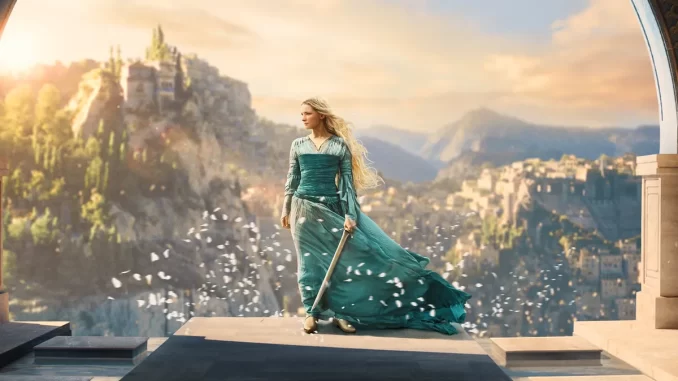
Greetings Narnians! It is my pleasure to introduce to you a series of in-depth analysis on the new Amazon Prime series The Lord of the Rings: The Rings of Power, which will be a series of videos deep into the series. This series will be produced by Dr. Scott Masson, and shared from his YouTube channel. I’ve asked him to answer a few questions that you might have about this endeavor, while we all still await news of Netflix’s Narnia series (which Dr. Scott Masson and I believe could have some forward movement based on The Rings of Power. (Whether in quality or in subscription numbers for Amazon Prime, we’re sure Netflix is watching this carefully.)
The following was written by Dr. Scott Masson.
Dr. Scott Masson is an Associate Professor of English Literature at Tyndale University, Toronto. He did his PhD at the University of Durham, where C.S. Lewis delivered the lectures eventually written under the title The Abolition of Man. He has taught courses on C.S. Lewis and J.R.R. Tolkien for over a decade, some of which have been uploaded to his YouTube channel. He also hosted a series of literature podcasts called Paideia Today.
The connection between C.S. Lewis and J.R.R. Tolkien
The legendary friendship of these two men was based on so many affinities they are difficult to summarize.
- Both men lost mothers in their early years, and Tolkien also lost his father. Their most famous protagonists have no parents to look for counsel or example. They thus look to heroic myth and legend, which they see not as a matter of antiquarian escapism but a deep-rooted connection of past to present, true for all.
- Both men also studied and taught the literature of the heroic age of English at Oxford University, where they met. They loved ancient and modern tales of the marvelous and the good. In Lewis’s case, he fused the love of old stories and myths with its assimilation and transformation by Christian thinking in the Medieval and Renaissance periods.
- Both men had a committed view of philology as the essential basis of their imaginative endeavors. In the case of Tolkien, his world-making was so extensive that he created new languages for his mythic characters, replicating his own academic work and fascination with etymology (the origin and historical development of a linguistic form). This idea undergirded their idea of archetypal human stories, and a careful study of Lewis and Tolkien’s fiction reveals that much of what seems novel is borrowing from sources, and ‘reforging’ broken swords.
- Both men were involved in the First World War, losing many friends in the process. The images of the experience of life as a battle has the realism marked by experience about it. Their emphasis on the necessity of virtue is far more prominent than interests in the means of waging war.
- Both men were Christians, and in the case of Lewis, his friend J.R.R. Tolkien led the self-described ‘reluctant convert’ to faith during a famous evening walk. The substance of their discussion about Christianity as a ‘true myth’ can be seen in Tolkien’s poem Mythopoeia. Their shared love of the forward longings of ancient myth was fulfilled in an ongoing present reality.
- Both men completed their mature fiction in the aftermath of the Second World War. The idea of the fall, which both men regarded as the quintessential human story, marked the plotline of all their fiction. In keeping with Lewis’s scholarly interests in the transformation of ancient myth by Christianity, the trajectory of Lewis’s fiction is more triumphalistic and victorious than is Tolkien’s, which has a gloomier mood of inevitable defeat and loss, and the mere hope of a future victory some have described as eucatastrophe.
The Rings of Power
Amazon’s new series The Rings of Power is based on The Silmarillion. The Silmarillion is the primary source for middle-earth’s entire ancient history, which extends back to an account of the origin of the gods that Tolkien calls its cosmogonic myth. The Silmarillion contains an account of the first age, as well as the account of the second age (largely from the viewpoint of the elves) though it includes the demise of the Kingdom of Númenor which is essential to the account of The Lord of the Rings. It also has a discussion of the beginning of the third age.
The Rings of Power is less ambitious than to tell the entire account of the two ages and the beginning of the third. It will be based on the fourth of five parts of Tolkien’s work The Silmarillion. This means that although it functions as background to The Hobbit and The Lord of the Rings, it has its own background which will not be featured in the TV series (though episodes from that background may be). One of my interests will be in how much it draws upon events of the past, as Peter Jackson’s films did for The Lord of the Rings.
Tolkien’s name for that fourth section of the Silmarillion is Akallabêth. It is the history of the second age.
The Second Age was the time-period of Arda (a period when the peoples of Middle-earth and Valinor [the undying lands] still dwelled together) which began after the climactic banishment of the evil Morgoth into the Void by the Lords of the West, the Valar (a quasi-angelic host of rulers). With the fall of the Kingdom of Númenor (a type of Atlantis), the earth was transformed such that men could no longer see or travel to Valinor.
The Third Age, with which most Tolkien enthusiasts will be familiar, began with the defeat of Sauron and his army by the last alliance of Elves and Men, which took place a century after the downfall of Númenor, and concluded with the departure of Gandalf, Galadriel, Elrond, Bilbo, and Frodo to the Undying Lands after Sauron’s final downfall recounted in The Lord of the Rings.
But we will be watching an account of the Second Age. It is a dark age, and not much of it is told. The brevity of Tolkien’s account is part of the challenge for the Amazon series. The Rings of Power will give the account of those Elves that ignored the stern counsel to return to the West at the close of the First Age, and chose to linger in Middle Earth. It will also be an account of the growth of the shadow in the East, and its spread to the realm of men, who proliferate even as the elves begin to fade. In Tolkien’s own words, ‘as the Second Age draws on, we have a great Kingdom and evil theocracy (for Sauron is also the god of his slaves) growing up in Middle-earth.’
I mentioned the challenge for the Amazon series lay in the paucity of details in Tolkien’s account. This will also be the opportunity for its writers to ‘fill in’ the gaps. The devil will lie in the details. What I will be looking for is whether the details are in keeping with Tolkien’s vision of world-building, but irrespective of my views, both the creators of the Amazon series and its audience will be making ‘arguments from silence.’
You can subscribe his YouTube channel now, and be prepared for a journey through The Rings of Power.
The Lord of the Rings: The Rings of Power – In-Depth Analysis
Season 1
Season 2
- In Production

